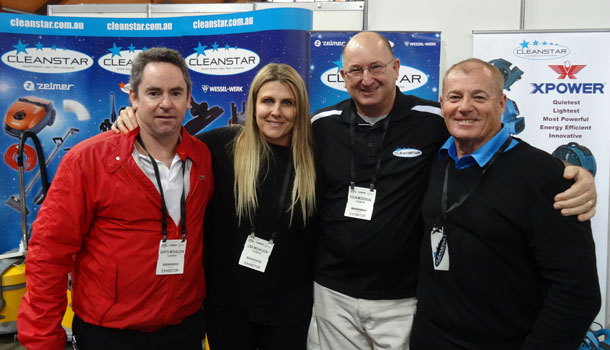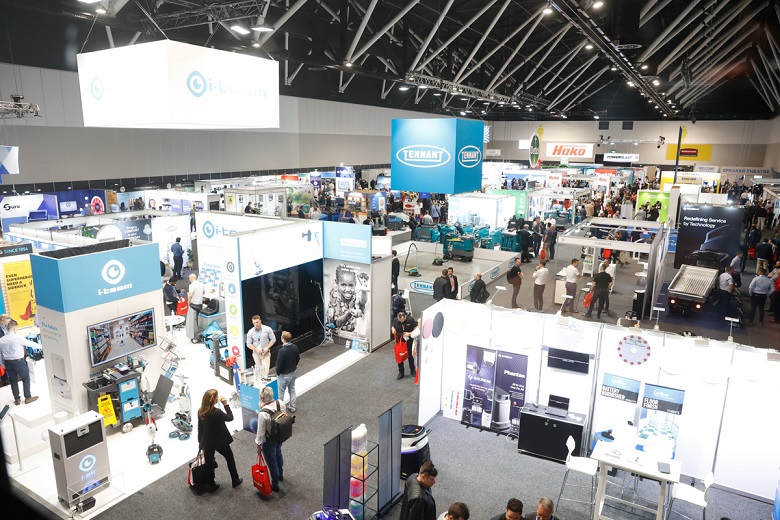
After a dramatic three years for the cleaning and hygiene sector, 2023 shapes as a critical and exciting year full of opportunities as the impact of COVID-19 starts to ease.
INCLEAN speaks with industry leaders to identify key issues that should be on the radar for business owners, executives and employees in the next 12 months.
1. Measuring indoor air quality
More and more facilities are starting to measure indoor air quality (IAQ) – and it is not before time, according to Dr Gavin Macgregor-Skinner, senior director of the Global Biorisk Advisory Council (GBAC).
The Washington DC-based infection-prevention expert says the importance of managing IAQ for health and safety reasons is well understood as a result of the pandemic.
“COVID-19 has made it an issue,” he says. “If you go back to the beginning of the pandemic it was all about filtration, but now with all the technology we have it’s more about air purification.”
Given that about 99 per cent of harmful particles in the air cannot be seen, Dr Macgregor-Skinner says measuring IAQ is crucial. Promisingly, a range of cost-effective monitors are available on this front.
“These devices are about the same size as a smoke detector. They’re very affordable and they give you real-time data on the air quality for 10 or 12 different air-quality parameters.”
As well as being ideal for facilities such as airports, schools and hotels, Dr Macgregor-Skinner is encouraged that such devices work well, too, in homes and small business settings.
“It’s doable and easy to interpret.”
He adds these devices are simple to set up and keep track of pollutants such as carbon dioxide, total volatile organic compounds, carbon monoxide, radon, formaldehyde and particles such as allergens, pollen and dust.
“Particulate matter are a mix of particles and droplets in the air, and the World Health Organization considers exposure to PM2.5 or less (fine particulate matter with a diameter of two-and-one-half microns) which cause cardiovascular and respiratory disease and cancers as the world’s single biggest environmental health risk,” Macgregor-Skinner says.
2. Promoting a sustainability agenda
For Steve Ashkin, founder of The Ashkin Group and renowned for his green-cleaning advocacy work in the United States, 2023 shapes as an important year to continue the fight for sustainability in the cleaning sector.
“I’m going to do my best to not only make sure this issue doesn’t go away, but that it really flourishes,” he says.
“Now that we’re post-COVID, this is the time to establish the sustainability agenda and go beyond all the green-cleaning stuff and the innovations that have taken place in the past few years. Sustainability is the next issue that I hope our industry will be paying attention to.”
Ashkin says a priority for him will be to clearly articulate that sustainability is different from green cleaning.
His sustainability drive will include focusing on how organisations act and operate, the ethical treatment of employees, energy and water conservation, superior fuel efficiency for fleet vehicles, as well as social issues such as fair wages, training and diversity.
With an eye to the future, Ashkin has been appointed to lead ISSA’s Global Sustainability Initiative. He says it is critical that sustainability campaigns target and educate developing countries where sustainability efforts are in their infancy.
“If we’re serious about doing something to make our world better, those are the people I want to work with,” he says.
“We’re planning on mentoring them, helping them transform their companies and giving them a competitive advantage.”
In this role, Ashkin says he will not be afraid to call out green washing.
“A lot of people want to believe what they’re doing is perfect and they don’t want anyone saying, ‘Well, that sounds like a bit of greenwash to me. Where’s the data to support all these claims you’re making?’ So, if we want to genuinely make a difference, that’s what I’m determined to do.”
3. Driving ESG principles
In tandem with sustainability, it is clear that environmental, social and governance (ESG) issues will also continue to be a major talking point in the next 12 months.
Vanessa Watson, founder of business consultancy Give and Take Co, advises clients on sustainability and ESG.
She expects tougher Australian legislation around single-use plastics to result in a significant packaging and materials overhaul for the cleaning sector. This anti-plastics push will be part of the evolution of a regenerative economy that reduces landfill.
“That’s got to be a thing of the past,” she says.
“We’re going to be transitioning away from plastics right throughout the supply chain.”
Watson acknowledges that such changes may be a challenge for some cleaning companies and product distributors because alternatives to plastics are not yet ubiquitous. The storage of harsh chemicals could also still require a reliance on more traditional packaging.
However, she says momentum for such reforms is unstoppable and requires a change of mindset among industry leaders, even if it comes with financial imposts in the short term.
“There’s going to be a cost to this and that’s the biggest challenge facing industry leaders today – accepting that the changing way that we must do business may cost us some money.”
Business advisor Kathryn Groening, who is an ISSA Oceania education and training consultant, believes an embrace of ESG is crucial to future business success.
“It works, it’s proven and it’s a way for a company to be successful and still do good at the same time,” she says.
Groening encourages cleaning enterprises to partner with a social or indigenous enterprise. This engenders great spirit within a business and employees “start telling their friends about it – that my company is doing this and that”.
“Most people don’t talk a lot about the day-to-day stuff in their company, but when they can talk about things that are meaningful to them, it improves morale, productivity and efficiencies.”
4. Embracing tech innovations
The rollout of new technology and the spectre of automation will continue to be a topic of debate in the next 12 months and beyond.
Brant Insero, ISSA senior director of education, training, certification and standards, expects two areas of tech to dominate:
- Robotics – “The labour shortage is still very real for our industry globally and will continue to be a struggle for the foreseeable future,” Insero says.
- Quality control technology – he predicts an increase in usage of inspection software, plus ATP meters that are used for detecting contamination on surfaces and in water.
Insero says validation of any services being performed will be critical in the competitive world for cleaning contractors.
“As it relates to in-house services, technology such as ATP and others will help their internal stakeholders recognise strong performance.”
Insero says the cleaning industry will continue to evolve courtesy of new methods that demonstrate to stakeholders the value of clean surfaces, clean air, and clean water.
“Invest in and embrace new technology, or technology that has been available but not utilised yet,” he advises.
“If we stand in fear, our competition will walk past us and thrive from their ability to leverage technology to their advantage.”
While organisations should take advantage of appropriate technology, it is wise to show a degree of skepticism and commit to testing.
“Organisations can’t believe everything they hear, but they should play the role of myth-busters. Test technology with open arms and see for yourself it will fit within your organisation.”
5. Ramping up training
Given that housekeeping and cleaning staff have been engaged in “life or death” work during the pandemic, the need for first-class training is obvious.
However, Smarter Skills head trainer Lesley Jones says too often cleaning employees are under-trained and under-prepared.
“It’s a systematic approach to training that’s lacking and which hasn’t been enforced in a way that it should have been,” says Jones, who has more than 30 years’ experience in health and aged care as a registered nurse, clinical educator and facility manager.
Many companies are relying on contract cleaners, but managers are so overburdened with work that they do not have the time to check if their suppliers are doing the right thing.
Jones hopes this flawed approach is rectified in 2023 and that appreciation for cleaners continues to grow.
“Generally speaking, everyone wants to do their best, but it’s about recognising housekeeping staff as some of the most valuable resources that we’ve got. We too often think of them as just cleaners and they’re not.”
She notes, for example, that cleaners in aged care settings often have to liaise with dementia patients and other people as they compete their work tasks.
6. Focusing on business fundamentals
There is an appetite for growth in the cleaning sector, according to Groening.
This will translate to an emphasis on a range of business fundamentals, including improving operational processes, streamlining cash flow and applying a HR lens to training, workplace safety, employee wellbeing and recruitment and retention.
“It’s critical we retain our staff and training is key to that,” Groening says.
“Even the correct induction process will help you keep people and that will be one of the keys to success.”
In other areas, Groening expects supply chains to again be an issue of importance in 2023. She advises being transparent about manufacturing and distribution challenges, and aligning your business to reliable, trustworthy and ESG-compliant partners.
“If you have amazing supply-chain partners they become part of your business. But if you cherry pick partners and say, ‘Oh, I can get this product for 10c cheaper, which could equate to a few thousand dollars over a year – you can cause overall damage to relationships and your business.”
Meeting supply-chain partners frequently is smart business, according to Groening, so you can tell them if your business’s usage rates have gone up or down and if any changes are required.
“For any effort you put in, you’ll get that back tenfold, particularly if you’re importing and make sure your supply chains and customers are okay.”
7. Addressing pricing and cash-flow management
While many economists believe Australia will avoid a technical recession in 2023, accountant Brad Horan says there is a feeling among many businesses that trading conditions are tough, nevertheless.
He believes one of the big challenges for cleaning businesses will be managing pricing in an environment of soaring inflation and rising interest rates. In September, inflation hit 7.3 per cent, the highest rate since 1990.
“Prices have gone up and, even if inflation goes back to 2 per cent tomorrow, the prices are not going to go backwards,” says Horan, a director at business advisory consultancy Lucrature, which services commercial cleaning businesses among other firms.
“There’s a real challenge for people to understand when and how they can pass those costs back on to their clients, or how they can optimise their business to absorb some of those costs.”
One option is to drive business efficiencies to push down costs. Another is to change pricing models to ensure they are more value-based for customers.
Horan suggests offering different services packages that come with low, mid-range and high-end quotes, rather than just giving clients one take-it-or-leave-it price.
“What a lot of cleaning businesses do is come in with one quote and they don’t really give options to customers. They’re really missing out on opportunities if they do that because you don’t always know where the customer sits.”
Businesses should be seeking to improve cash-flow through measures such as finetuning the collection of outstanding debts. “A lot of clients don’t do that well,” Horan says.
8. Combatting staff shortages
With immigration levels down substantially and COVID-19 causing ongoing sickness issues and absenteeism in the workplace, staff shortages are again expected to be a problem for the cleaning sector in 2023.
Jones says this is especially likely to be so in the aged care sector, where work requirements can be demanding, while exposure to viral infections is often high.
“The biggest challenge will be employing and retaining staff that fit into this new arena of cleaning,” she says.
Jones advises looking after your staff in ways that suit both the employer and worker. “For example, staff need flexibility and a decent take-home pay. They need a sound job role with up-to-date training. They also need some training and experience of working with elderly clients, especially those with changed behaviours.”
With regard to wages, Jones says cleaning staff are fulfilling crucial hygiene services, in addition to a social role at aged care and retirement facilities, where they often have to engage with patients in rooms.
“That’s a big role and should be paid well,” she says.
Horan agrees that there is no quick fix for the staffing crisis in the cleaning sector. He says COVID-19 has convinced many workers to switch careers, while immigration inflows are still slow.
“We’ve got a smaller workforce to support a larger economy and that’s not going to go away tomorrow.”
To woo staff, Horan suggests trying to give people a sense of purpose in their job and allow staff to be part of the business. Measuring job happiness and outcomes can also be invaluable.
What companies cannot do is be complacent and sit on their hands.
“In the past the cleaning industry has expected a high turnover and thought they’d pick up people who needed work and burn them out and then get more employees,” Horan says. “But there aren’t any more.”
9. Validating cleaning efficiency
Simply telling your clients that you are cleaning hygienically will no longer cut it. You have to prove it, says Dr Macgregor-Skinner.
“The big-ticket item on your list is validation of what you do – instead of just concentrating on the smell and the appearance of facilities after a cleaning job, it’s the metrics and measuring of the level of cleaning that’s so important.”
That means demonstrating pre-clean measurements versus post-clean results. Dr Macgregor-Skinner says there is also a shift towards scientific and evidence-based cleaning that can actually bring efficiencies and lead to cleaning cost-savings for facilities. For example, during COVID-19 the tendency to replace HEPA and MERV filters too often caused cost blowouts.
“2023 for me in the cleaning industry is going to be the year for metrics, the year for data, and the year for solutions that are based on information and data.”
Ashkin agrees that data is becoming increasingly important.
“Measurement is going to become one of the big mantras going forward, whether we’re talking about greenhouse gas emissions or green STEM reports. Fundamentally, our role is to clean and sometimes we need to do a better job of making sure that’s exactly what we’re doing.”
10. Selling the cleaning industry’s merits
Building on gains made during COVID-19, Ashkin hopes the cleaning industry keeps highlighting why cleaning is important in discussions with governments, businesses and people.
“It’s our responsibility to make sure we find our voice and really provide leadership to inspire and encourage people to do more and really reward companies that are committed to the future. That’s really on us.”
It also includes being up-front with clients about cleaning best-practice.
“It’s often hard in a service industry – we’re more accustomed to telling people that we’ll do whatever they ask,” Ashkin says.
“We’re not as good at saying, ‘Wait a minute – here’s what you need to be doing from a cleaning perspective.’ I hope we’ll find our voice and be willing to suffer the challenges of leadership.”
This article was first published in the January/February issue of INCLEAN magazine.
Read the original article here.
Comment below to have your say on this story.
If you have a news story or tip-off, get in touch at info@incleanmag.com.au
Sign up to INCLEAN’s newsletter.





